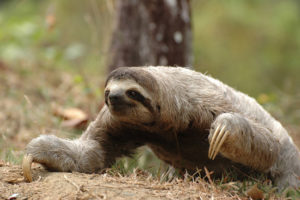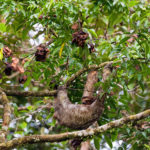Sloths
 In the dense forests of South and Central America, you can meet a funny creature with long limbs, equipped with three huge claws, little eyes-slits and funny muzzle. When you look at him, you get the impression that the animal is always in a good mood and a smile never comes from his face.
In the dense forests of South and Central America, you can meet a funny creature with long limbs, equipped with three huge claws, little eyes-slits and funny muzzle. When you look at him, you get the impression that the animal is always in a good mood and a smile never comes from his face.
Giant sloths lived almost 40 million years ago, their growth was about 6 meters, and weight – several tons. So, in terms of their dimensions, they could well compete with dinosaurs, which also differed in their large dimensions. It is clear that such giants could not climb trees (and what kind of tree they will withstand), so they led a terrestrial way of life. Archaeological excavations have shown that giant sloths caught the ancient Indians of America, and disappeared, like many ancient animals, as a result of the last ice age. Yes, and people, most likely, also put their hands on this: the sluggish giants were easy prey for the hunter.
The time of the giants has passed, but modern sloths have a little brother – a dwarf sloth, which can be seen only in one place on our planet – on the island of Escudo de Veraguas, near Panama. From ordinary sloths it is distinguished by small sizes and a brown strip on the forehead, and habits and lifestyle are the same. Dwarf sloths in nature are very few (less than 500 individuals), the population has not yet been able to increase due to the hunt for them by local residents, plus it is caught and sold to European and American countries where exotic animals are lovers who buy dwarf sloths in As pets.
Three-toed sloths justify their name, a slower and less moving animal is hard to find! Sloths are the slowest mammals of the Earth. Almost all the time they hang on the tree with their backs down, clinging to the branch with powerful claws. And their limbs are not weak, capable of keeping the weight of the animal for many hours (about 6 kg). Sleeping sloths about 10 hours, and the rest of the time either hang motionless, or move, but very slowly. Nature has created sloths the opportunity to get delicious, juicy leaves, almost without stirring, thanks to the long neck, which is very flexible and can be rotated 270 degrees.



























